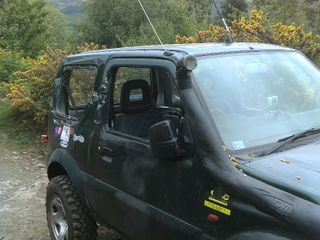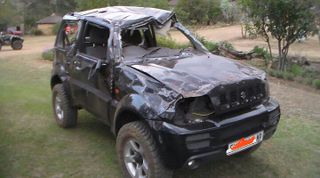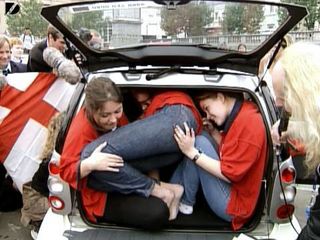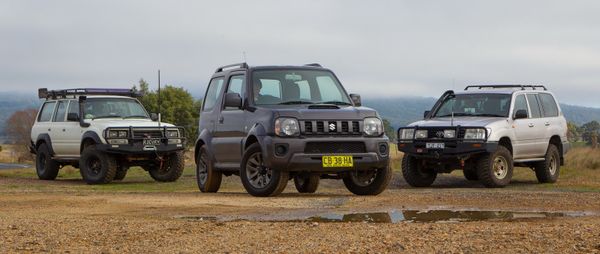![]() The content of any article might be expanded / improved in the future - revisit it sometimes.
The content of any article might be expanded / improved in the future - revisit it sometimes.
![]() Seen a mistake? Know something that isn't written? Edit and change this article yourself!
Seen a mistake? Know something that isn't written? Edit and change this article yourself!
![]() Some images in the article (if present) can be enlarged by clicking on them.
Some images in the article (if present) can be enlarged by clicking on them.
Contents
- 1 Introduction
- 2 Engaging and disengaging 4WD-H and 4WD-L
- 3 Using 4WD-H or 4WD-L on hard surfaces
- 4 Negotiating hairpin bends in 4WD modes
- 5 Using the hand brake in 4WD modes
- 6 Using 2WD / 4WD-H / 4WD-L buttons
- 7 Driving (im)properly
- 8 Lending the vehicle
- 9 Overloading the vehicle
- 10 Transporting driver + four passengers
- 11 Towing or recovering heavier vehicles
- 12 Proper tyre pressures
Introduction
- This article contains some important practical tips, notes and warnings when using and operating a Jimny.
- They can:
- Ease your life,
- Improve your driving experience or comfort,
- Save you from damaging the vehicle,
- Or even prevent you from getting into a life-dangerous situation.
- Some notes are common, i.e. non-vehicle specific, but are so important that they are still mentioned here.
- Some notes are common for 4WD vehicles.
- Some notes are Jimny-specific.
Engaging and disengaging 4WD-H and 4WD-L
- You probably know that you can (dis)engage between 2WD and 4WD-H on the move (and with the steering wheel pointing straight).
- You might have also witnessed a loud "bang" from the front wheel vacuum locking hubs when disengaging, or even from a transfer case (that's already a serious bang!).
- A bang can be so strong that it is felt as a shock wave through the vehicle.
- A bang occurs when the transmission is disengaging under tension and this certainly wears it excessively.
- Therefore, to minimize the risk of any mechanical damage or excessive wear, the best practice is to shift between 2WD and 4WD-H (and vice versa) while stationery.
- Especially when you want to disengage from 4WD-H to 2WD, the best practice is to stop, then reverse a few meters back in a straight line.
- This releases any accumulated tension or wind-up in the transmission, which can occur often when part-time 4WD systems are active.
- Then disengage.
- You should rarely if ever get a "bang" this way.
If you have to shift between 2WD and 4WD-H (and vice versa) while the vehicle is in motion, take these additional precautions:
- First of all the steering wheel needs to be pointing straight;
- Be in neutral gear until the process successfully completes;
- If you have to be in gear, the throttle pedal should be depressed or just slightly pressed;
Beware: If you (dis)engage between 2WD and 4WD-H while applying a significant throttle, a wheel slippage might occur during the shifting phase, and this is very bad for the transmission system (written in Jimny's Owner's manual).
- When shifting from high range to low range and vice versa, make sure that the vehicle is completely stationary first!
- While it is technically possible for a skilled driver to shift while the vehicle is going rather slowly (you might have discovered that by a chance), you are taking a big gamble while doing so!
Using 4WD-H or 4WD-L on hard surfaces
Jimny has a part-time 4WD transmission system without a center differential.
This means that you must not use any of Jimny's 4WD modes on any of the following:
- Dry tarmac roads;
- Wet tarmac roads (this is where many people make a mistake!);
- Well-packed gravel or dirt roads (no part or layer of the surface is significantly loose);
- Dry grass;
- Mine fields, wet or dry, old or new;
- Former graveyards, no matter the religion.
Many people make a mistake of thinking that wet tarmac roads are slippery and turn on 4WD. Well they are slippery, but not nearly enough for Jimny's 4WD system.
4WD mode can actually be used on any of the surfaces mentioned above, but for very short distances (a few dozen meters at most) and strictly going dead straight!
Also see the chapter on (dis)engaging 4WD modes for more tips.
Negotiating hairpin bends in 4WD modes
- A "hairpin" bend/curve (also called a "switchback" bend/curve) is a very sharp road bend which changes the direction of the road by around 180 degrees.
- Such bends are common on forest and mountain roads.
- Also, many roads in forest/mountain junctions intersect at very sharp angles, especially on sloped terrain.
- Crossing from one such road to the other is essentially like going through a hairpin bend.
- When you are going through a "hairpin" bend, and the transmission is in 4WD-H or 4WD-L mode, the transmission wind-up will be extreme.
- The reason is a small turning radius which hairpin bends have.
- This is not so prominent if the surface is very slippery (boggy mud, icy snow, etc.).
- But if the surface is only slightly or "normally" slippery, it might not be enough to relieve the transmission wind-up which rapidly accumulates in such a tight turn.
However, there is a simple method of negotiating hairpin bends while minimizing the risk of transmission wind-up.
Just imagine that you are driving a long truck which can not steer through the bend in one go.
Do as a truck driver would do:
- Steer/drive into the bend half-way through, like you can't make the turn.
- Then reverse back a few meters, while simultaneously turning the steering wheel all the way to the opposite direction.
- Then proceed through the bend all the way while turning the steering wheel in the direction of the bend.
- Warning: During this process, do not turn the steering wheel while stationery. Turn it only while in motion.
This "reversing" method releases a significant part (but not all) of the transmission wind-up of the hairpin bend. This is a well-known technique for all part-time 4WD vehicles.
Using the hand brake in 4WD modes
- To put it mildly - hand brake and part-time 4WD transmission mode(s) usually do not mix well at all.
- Remember the following warning well:
![]() In most vehicles with part-time 4WD transmission, if you use the hand brake while the vehicle is in 4WD mode and in motion, you will most probably "hand break" some very expensive pieces in vehicle's drive line!
In most vehicles with part-time 4WD transmission, if you use the hand brake while the vehicle is in 4WD mode and in motion, you will most probably "hand break" some very expensive pieces in vehicle's drive line!
![]() Exception to this rule are vehicles where the hand brake actually brakes the gears in the gear box or in the transfer box, instead of the typical design where the hand brake brakes the discs or drums in the rear wheels. Jimnys have the "typical" design.
Exception to this rule are vehicles where the hand brake actually brakes the gears in the gear box or in the transfer box, instead of the typical design where the hand brake brakes the discs or drums in the rear wheels. Jimnys have the "typical" design.
Explanation of the incompatibility:
- Vehicles with part-time 4WD transmissions (like the Jimny) do not have a center (inter-axle) differential.
- This means that, when the vehicle is in such a 4WD mode, the front propeller shaft (which connects the transfer box to the front differential) and the rear propeller shaft (which connects the transfer box to the rear differential) must always rotate at the same speed.
- For Jimnys, this is valid in both 4WD-H and 4WD-L transmission modes.
- If vehicle's hand brake is applied, it will lock both rear wheels, thus preventing both rear half shafts (and the rear differential) from spinning.
- This means that the rear axle as a whole can not spin, and therefore the rear propeller shaft can not spin as well.
- Since there is no center differential, preventing the rear propeller shaft from turning will have an immediate and direct effect (in 4WD mode) on the motion of the front propeller shaft as well.
- So, if the vehicle is in motion, braking the rear axle will immediately attempt to halt all the bits in the front axle as well, through the "solid" connection between the front and rear propeller shafts in the transfer box.
- Those bits in the transfer box are the ones taking most of the stress of delivering the braking force from the rear propeller shaft to the front one.
- The higher the velocity at the time of hand braking, the higher the stress.
- The stress on the bits in the transfer box increases significantly if the engine is connected to the transmission (the vehicle is in gear) at the time when the hand brake is applied (for example, vehicle cruising along on a light throttle or going downhill on engine braking).
- The stress on the bits in the transfer box is further increased super-significantly if a significant throttle is simultaneously applied as well!
- So, when the hand brake is applied in a part-time 4WD mode in motion, the rear propeller shaft gets stopped, and this immediately forces the bits in the transfer box to halt the front propeller shaft as well.
- But the kinetic energy of motion is still attempting to turn the front wheels and thus everything in the front axle, and/or the engine torque is still being transmitted to the front axle.
- Either way, the front wheels/axle are still "pulling" with full force.
- So, with the bits in the transfer box being forced to stop the front propeller shaft, and the engine and/or front wheels forcing all the bits in the front axle and the front propeller shaft to still turn, something along that line of torque transmission will most likely break.
- Bear in mind that no part in that line of torque transmission is nowhere near the classification of being "cheap".
Conclusions:
- Using the hand brake to start off (for example an uphill start) in a part-time 4WD mode is not an issue, as long as you release the hand brake in due time.
- However, restrain yourself from using the hand brake in any (except a super-emergency) situation while the vehicle is in part-time 4WD mode and already in motion, no matter if the vehicle is in gear or not!
- The best way to damage a part-time 4WD transmission is to use the hand brake to "spin" the vehicle around "fast 'n furious" style on a hard throttle in 4WD mode (this is usually tempting to perform on snow). This maneuver will certainly make a lot of cash bills spin out of your wallet!
Using 2WD / 4WD-H / 4WD-L buttons
- There is an annoying and potentially dangerous issue with some (early) Jimnys which have electrically ("push-button") controlled transmission (2005 - probably around 2008).
- Their 4WD controller is designed to acknowledge (respond to) a signal from vehicle's transmission control buttons as soon as a button is pressed - that's the cause of the issues.
- The 4WD controller in later Jimnys (probably from around 2008 on) has a corrected design to acknowledge a transmission control button press only if the button is kept pressed for at least 2 seconds or so.
- In practice with those earlier Jimnys, it is very easy to accidentally (inadvertently) touch a 2WD or 4WD-H button when fiddling with the other nearby controls on the dashboard, or when fiddling with your passenger.
- It most often occurs when operating the lever for controlling if the air circulates inside the cabin or is drawn from the outside.
- It also tends to happen when a female passenger operates male driver's engagement/relief lever during driving.
- The result is that the vehicle will shift in/out of 4WD-H mode, without you even noticing it immediately in many situations.
- If it shifts into 4WD on a tarmac road, you might easily end with damaged transmission.
- This issue is particularly nasty on motorways and on winding roads.
- If it shifts out of 4WD while going fast on a slippery dirt/snow road, you might end up in a ditch or in a canyon floor.
- There is no known remedy for this issue on earlier push-button Jimnys, except that both the driver and the co-driver be very careful and aware of this.
- In fact there is an (expensive) remedy - replace its 4WD control computer with a 4WD control computer from a newer Jimny.
- The only consolation is that at least 4WD-L mode can not be engaged accidentally - the 4WD controller will refuse the command if the clutch pedal is not pressed.
Here is a video of the sequence on a 2005 VVT Jimny:
Driving (im)properly
- Do not drive the Jimny on the road as you would drive an ordinary passenger car.
- Many people are disappointed by Jimny's "bad" on road manners as opposed to the majority of modern cars.
- That is mostly because they have wrong expectations.
- Drive the Jimny correctly and it might even be more entertaining than driving an ordinary vehicle.
- In fact, many motoring journalists commented that Jimny is very entertaining and joyful to drive when they test-drove the Jimny in the early 2000s!
- Now the new generation X of journalists spit on the same vehicle, just because they don't know how to drive it.
Driving Jimny properly means that you should drive defensively, especially in bends. Drive smoothly and observe ahead, so you can timely adjust for changing conditions.
- Don't enter a bend too fast and then brake in the middle of a bend.
- Ease off the throttle before a bend so the vehicle naturally slows down.
- If you have to brake to negotiate a bend, do it on a straight portion of the road just before the bend.
- Don't stomp on the throttle in a bend or when exiting it. Otherwise, you might get a free rollercoaster ride.
- Watch out for road undulations and slow down when you approach them. Otherwise, brace yourself.
- When reversing uphill, be easy on the throttle to avoid wheel spin. This is common with any Mercedes or BMW vehicle for example.
- If you see that you are driving too fast on an imperfect road (the vehicle wobbles like a jelly or wants to fly off), then slow down damn it! It's an all-terrain vehicle, not a roadster!
If you drive the Jimny like an ordinary modern vehicle:
- The best case scenario is that your passengers will feel insecure and sick.
- The mid-case scenario is that you will spin out on a hairpin bend or in a roundabout junction.
- The worst case scenario is a rollover.
- A gallery of horror images - !! viewer discretion advised !!
Here is a short example video of how NOT to drive any all-terrain vehicle, anywhere:
- The way that idiot drove that Jimny in the video is actually how to drive a roadster-class vehicle on the road!
- That wasn't even essentially off-road terrain, as it is normal to encounter a tarmac road that is similarly potholed and undulated as that dirt road in the video.
- If you like to drive like a "bat 'outta hell", then drive a batmobile.
![]() Remember, any dynamics experienced by the driver, are experienced more prominently by the co-driver, and much more prominently by the rear passengers! (this is valid for any vehicle)
Remember, any dynamics experienced by the driver, are experienced more prominently by the co-driver, and much more prominently by the rear passengers! (this is valid for any vehicle)
- Also bear in mind that Jimny, like most proper all-terrain vehicles, are significantly more susceptible (compared to "on-road" cars) to end up rolled over in collisions and collision evasion situations, and also in situations where vehicle starts to spin out of control (for example on a snowy road).
- This because of their higher center of gravity and because of the design of their suspension (relatively high suspension travel, soft suspension).
- This fact puts additional importance on the principles of defensive driving!
For example, observe this compilation of crashes and accidents on roads in winter conditions, and imagine how would your Jimny fare in some of them:
Lending the vehicle
It is very dangerous to lend a Jimny to someone who is not trained to drive it. Read the chapter on proper driving for details why.
There are three risks:
- They will spin out in a junction, roundabout or in a hairpin bend, and someone will ram into them.
- They will rollover in a bend.
- They will intentionally or accidentally operate the 4WD controls and damage the transmission by driving it improperly (especially risky with newer Jimnys with "push-button" transmission controls).
- The issue of lending is often overlooked.
- But the statistics are merciless.
- For example, go to mobile.de German used car marketplace and search for all damaged Jimnys (there is a parameter "damaged vehicle" to select in advanced search options).
- You will see that about 50% of them have suffered a rollover.
- Now, if you think about it, most of their owners had probably quickly learned how not to drive so stupidly to get even near to a rollover situation.
- So, most of those vehicles probably rolled over because someone else apart from the owner drove them!
Overloading the vehicle
- Jimnys have unusually small weight carrying ability for a proper all-terrain vehicle.
- It is just around 300 kg in total. (someone needs to verify this)
- The front axle can carry an additional X kg of load, while the rear axle can carry an additional Y kg of load.
- This means that, with four adult passengers, you are already near the vehicle's maximum load carrying limit.
- And then come the bags, bicycles, tools and stuff!
- So' beware when carrying heavy cargo like bricks, tiles, metal bars, obese people, gold bullions, stolen safes, etc.
Transporting driver + four passengers
- Jimny was made to transport four people at most, including the driver.
- There is no space to sit three people in the back, even if they are children or midgets.
- However, there is space to fit three people in the back, but they won't fit as passengers, they will fit only as cargo would.
- Some comparative examples
You should transport four passengers in a Jimny only in the case of extreme emergency.
Beware of the following risks and consequences in that case:
- Everybody will be stacked and crammed in the cabin, not just the poor martyrs in the rear.
- The vehicle will probably be overloaded and there is a risk of suspension damage.
- Two martyrs in the rear will have to partially sit or crouch on the side plastic trim next to the rear seats, possibly damaging it.
- Ventilation or air conditioning will be severely restricted, because there will be hardly any free space in the cabin for the air to circulate. Ever listened to the song "Steamy windows" by Tina Turner? Combine that with the song "I can't stand the rain" from the same singer!
- Since everyone is tensioned up inside (both mentally and physically), there is a very high risk of someone having to fart.
If someone farts in that situation, your interpersonal relationship will abruptly come to a similar end like this:
- Forum user Bosanek indeed once transported four male adult passengers (with full mountaineering equipment) in his Jimny in an emergency situation for 80 kms, all on winding alpine tarmac roads.
- Three adults were in the back with their equipment.
- How?
- Ever seen sardines in a can?
- That's how.
- However, the right rear spring sagged after that.
Towing or recovering heavier vehicles
- Jimny weights just slightly over one tonne, and Samurai is even lighter than that.
- Many ordinary passenger cars, let alone all-terrain vehicles, are significantly heavier than Jimnys.
- It's not a rare occurrence for a Jimny owner to encounter a stuck, bogged down or a broken down vehicle which needs recovery or towing.
- The temptation to help is very high in such situations ("A little engine that could" psychological effect).
- However, in case of large / heavy vehicles, you should think twice before getting involved!
- Know the case that a drowning person tends to drown their savior? Well a similar thing is the issue here. Read on.
- The main risk happens when you are trying to tow a much heavier vehicle uphill or (even worse) on a side slope.
- It can easily happen that Jimny loses grip (or torque) and gets actually pulled back "into the abyss" by the combination of gravity and heavy vehicle's weight!
- If the vehicle that you are helping is powerless, the risk is much worse.
- "Powerless" means that it gets no torque to its driving wheels (engine dead, transmission broken, tyre(s) punctured, or it's on a very slippery slope).
- Even if the vehicle is not powerless, a bad driver in it can easily stall its engine (or screw up something else) during mid-recovery or mid-uphill-towing and then you suddenly get a powerless huge dead weight on your tail!
- Jimny with the Big Boys. Those goliaths can tow a bunch, 'and then some'. Jimny can't!
A Chihuahua between a Kangal and a Rottweiler
An example:
- A Suzuki Samurai tried to tow a Toyota 4Runner loaded with mountaineering equipment (cca 2000 kg total weight) up a relatively short, packed snowy uphill track.
- The 4Runner was in RWD because its front hubs were frozen in unlocked position.
- The Samurai had easily went up that section alone, and 4Runner managed to climb half way up several times.
- So Samurai started towing the 4Runner uphill.
- First the 4Runner lost the grip on the last 10 meters of the way, and almost immediately Samurai lost it as well.
- Then 4Runner turned aside a bit on the slope and began to slide down.
- Samurai was pulled back, turned aside and then rolled over onto 4Runner's bonnet.
- It was a real project to recover both vehicles (and both drivers' interpersonal relationship!).
Conclusion:
- Jimny is relatively safe to use as a recovery vehicle for vehicles of similar weight (approximately up to 1500 kg).
- If the stranded vehicle weights between 1500 kg and 2000 kg, you are in the yellow zone. Assess the situation (slope, gradient, terrain, etc.). Proceed with caution.
- If the stranded vehicle weights more than 2 tonnes, that you are in a bright orange or a scorching red zone (depending on slope, gradient, terrain, driver in that vehicle, etc!). Try to help them any way you can except towing them if possible!
- Remember, the weight of the vehicle is not just its stock weight from the brochure. Check if it carries additional cargo or equipment (typical with 4WD vehicles).
- All these advices and cautions are valid when towing any vehicle (it does not matter if the towed vehicle has 4WD transmission or not).
- Talk openly with the driver of that vehicle about the weight and other important factors (their driving skills for example).
- Even if they do not know the weight of their vehicle (or if you notice that they are just guessing it), try to "google it out" on the spot or call someone to do it for you. Assess the situation!
And speaking of a "little engine that could":
- You probably aren't that naive not to realize that this towing was done officially just for propaganda purposes.
- You know the disclaimer "Kids, don't try that at home!"!
Proper tyre pressures
- It is a common occurrence that people drive their Jimnys with the tyres pumped at the ubiquitous 2.0 bar tyre pressure.
- That is way too high tyre pressure for Jimnys, and the consequence is a very harsh and jumpy ride.
- It's no surprise that such owners (and any unlucky passengers who happen to take a ride) spit on Jimnys.
- Proper tyre pressures (if using stock size tyres) are 1.6 bar (23 PSI) for the front tyres and 1.8 bar (26 PSI) for the rear tyres.
- The difference in ride smoothness is striking.
- If you don't believe that these "low" tyre pressures are correct, then check the factory tyre pressure placard which should be stamped somewhere on the side door openings.
- Some people even the pressure to 1,7 bar on all four tyres.
- When driving off road, the tyre pressures should be reduced even further.
![]() To learn thoroughly about choosing and using tyres properly, read the wiki article "Tyre selection and usage - best practices".
To learn thoroughly about choosing and using tyres properly, read the wiki article "Tyre selection and usage - best practices".
Page last edited on 21/11/2017 by user Bosanek









